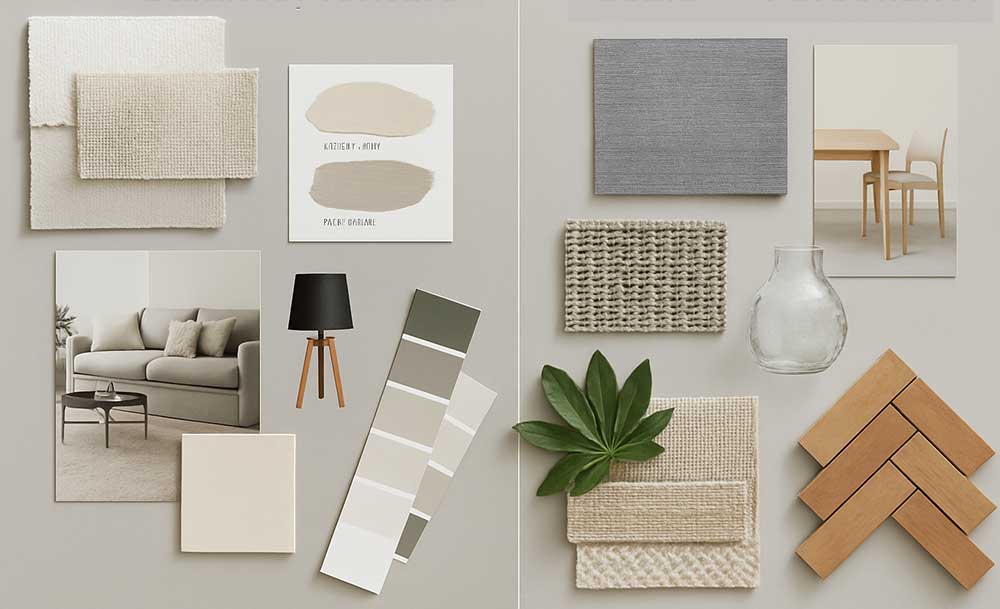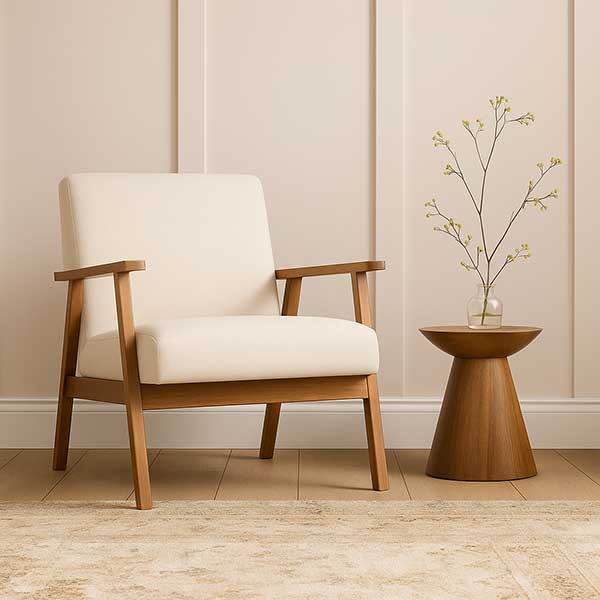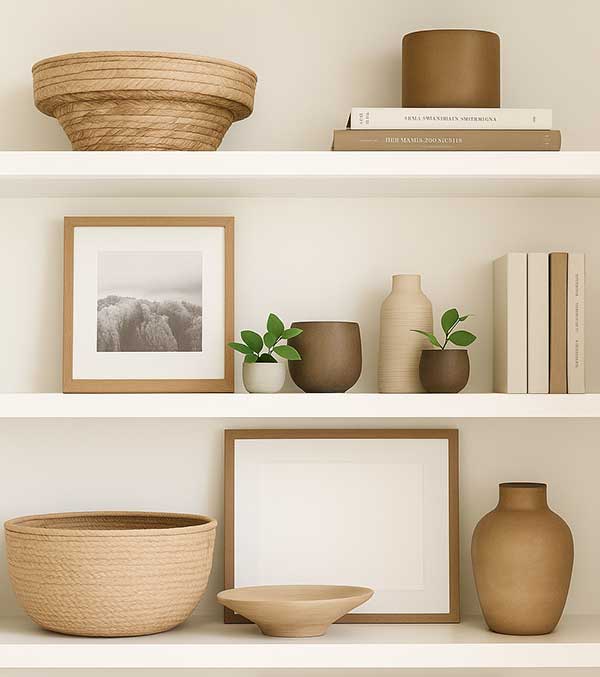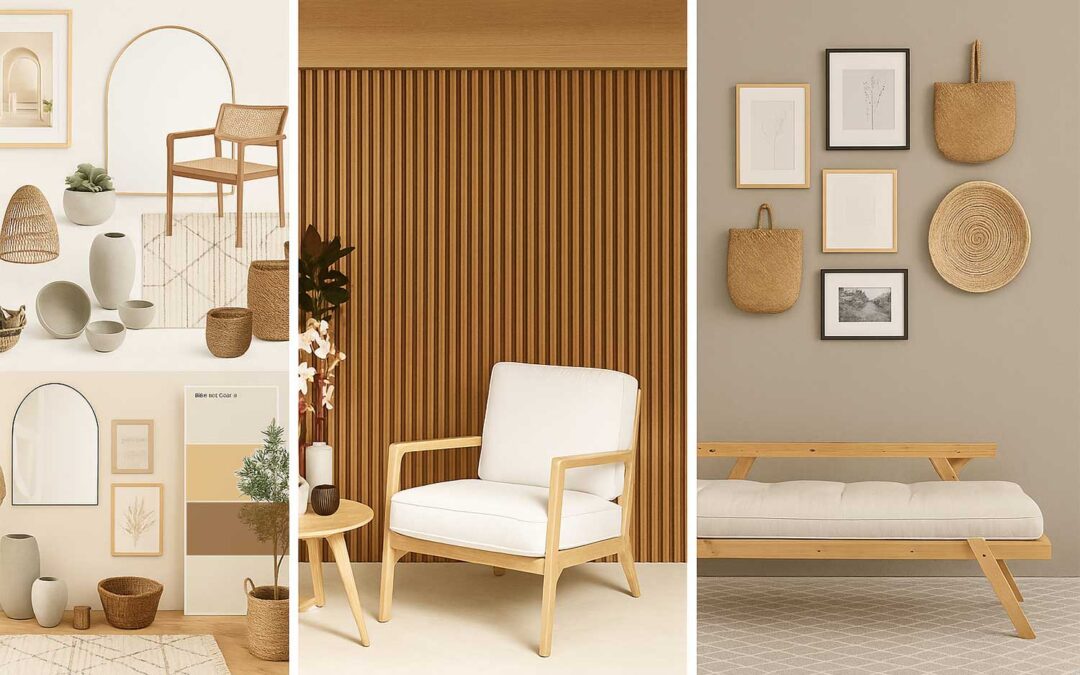Our interior styling guide is all about turning your home into a place that feels stylish, welcoming, and uniquely yours.
With a few clever tricks and thoughtful touches, you’ll discover how to bring out the best in your space, whether it’s a full makeover or just a little refresh.
1. What Is Interior Styling?
Interior styling is the process of arranging decor, furniture, and accessories to create a cohesive and stylish look in your home.
It’s more than just placing furniture or adding pretty decor; it’s about designing a space that feels intentional and reflects your personality.
Done well, interior styling can make a space feel fresh and inviting, no matter its size or budget. It’s the magic that transforms a house into a home, where every corner feels thoughtfully put together.
What is the Difference Between Interior Design and Interior Styling?
Interior design focuses on a space’s structural layout and functionality, from the walls to the flooring and even the lighting plan.
Interior styling, on the other hand, hones in on the visual details: how a throw blanket is draped, how a gallery wall is curated, or how textures and colours are layered.
These thoughtful finishing touches give a room its soul and make it feel truly lived-in and loved.
2. Core Principles of Interior Styling
When it comes to creating a space that’s both stylish and welcoming, a few core principles of interior styling make all the difference.
Let’s break them down:
-
Balance
Think of your space like a scale; every item you add should create harmony. Balance bold colours with soft neutrals, mix large furniture with smaller accents, and distribute visual weight evenly throughout the room.
-
Texture
Texture is the secret to adding depth and interest. Combine different materials and finishes, such as smooth ceramics with woven baskets, or sleek metal with plush fabrics, to create a layered and tactile look.
-
Colour
A well-chosen colour palette ties everything together. Start with two or three main colours and weave them through the space with textiles, accessories, and art. This creates a cohesive and polished feel.
-
Scale
Proportion matters. Oversized pieces, like a large artwork or statement mirror, can make a space feel grand, while too many small items can create visual clutter. Aim for a mix that feels intentional and balanced.
-
Personality
Infuse your space with pieces that tell your story. Whether it’s travel souvenirs, vintage finds, or family heirlooms, these personal touches make your home feel uniquely yours.

3. Practical Styling Tips for Every Space
Before you begin, take a moment to create a moodboard. This simple tool helps you visualise how your chosen colours, textures, materials, and decor will work together before you commit to them. It’s your styling roadmap, ensuring your space feels cohesive and intentional.
Here’s how to use your moodboard
- Gather inspiration: Use magazine cuttings, Pinterest boards, paint swatches, fabric samples, or even digital collages. Choose pieces that speak to your style and complement each other.
- Test combinations: See how different textures (like linen vs. velvet), materials (wood vs. metal), and colours (neutral base with bold accents) interact.
- Refine your vision: Swap or remove elements until the overall look feels balanced and harmonious. This saves time and prevents costly mistakes.
- Bring it to life: Once you’re happy with the moodboard, use it as a reference when selecting furniture, decor, and accessories for your room. It will keep you focused on the look you’re aiming for.
How to Apply Your Moodboard to Core Styling Principles
- Balance: Start by assessing your room. If one side feels too heavy with furniture or decor, balance it out with larger items or a gallery wall on the other side. Remember, balance doesn’t have to mean symmetry; it’s about creating harmony.
- Texture: Layer different textures to add depth. For example, pair a velvet cushion with a linen sofa or add a knitted throw to a leather armchair. Natural elements like wood, rattan, and wool instantly bring warmth.
- Colour: Stick to a consistent colour palette with two or three main colours and a few accents. Use a mix of soft neutrals as a base and introduce bolder colours through accessories like cushions, rugs, or art.
- Scale: Play with proportions. If you have a large, empty wall, consider oversized artwork or a tall plant. In smaller spaces, avoid too many tiny items that can make the room feel cluttered. Go for one statement piece instead.
- Personality: Incorporate personal touches such as family heirlooms, travel souvenirs, or a quirky vintage find. These details not only make your space unique but also tell your story.
Quick Tip: When in doubt, step back and assess your space from different angles. Does it feel inviting? Are the elements working together? Trust your instincts and don’t be afraid to experiment!
4. Styling Each Room: Practical Tips
Living Room
Create a focal point, whether it’s a fireplace, artwork, or a well-styled coffee table. Play with cushion arrangements, layering throws, and adding plants to bring life to the space.
Bedroom
Layer bedding with different textures and tones; think crisp sheets, a chunky knit throw, and patterned cushions. Add a statement headboard or a feature wall for extra style points.
Kitchen & Dining
Keep surfaces clutter-free but styled with practical yet beautiful items like a fruit bowl, a vase of fresh flowers, or a set of curated cookbooks. Open shelving can be a canvas for styled displays and practical use. Remember not to overdue.
Bathrooms
Introduce texture and softness through textiles like towels and rugs. Add plants for freshness, and consider a tray with candles or bath essentials to create a mini spa vibe.
Hallways & Staircases
Style with a mix of framed art, mirrors, and perhaps a narrow console table with a lamp or statement piece. Don’t forget about the stairway – a feature wall or gallery-style photo arrangement can create visual interest.

5. Styling Mistakes to Avoid
Even the most stylish spaces can fall flat if certain missteps aren’t avoided. Here are common interior styling mistakes and practical ways to sidestep them to ensure your home feels inviting and well-curated.
- Overcrowding shelves: Avoid cramming every inch with decor. Use the rule of three to group items, mixing heights and shapes for visual interest.
For example, stack a few books to create height, add a small vase, and lean a framed photo or art piece as a backdrop. Leave negative space between groups to give the eye a place to rest and make each arrangement stand out. - Ignoring scale: A tiny rug in a large living room or an oversized lamp on a small bedside table can disrupt balance. Always consider proportions. A good tip is to choose a rug that anchors all your main furniture, and opt for lighting that complements the scale of the room.
- Neglecting texture: Smooth surfaces alone can feel flat. Combine soft throws with rough baskets, velvet cushions with natural wood accents, or add a chunky knitted pouf to a sleek sofa. These contrasts bring depth and interest.
- Colour overload: Too many bold colours competing for attention can be overwhelming. Stick to a palette of two or three main colours and add subtle variations through accessories and artwork. If you love bold hues, introduce them in smaller doses through cushions, vases, or art.
- Ignoring personality: A home should reflect you. Incorporate personal touches, like a collection of postcards from your travels, vintage family photos, or that quirky lamp you fell in love with. These pieces add warmth and character.
- Overmatching: Avoid buying entire matching sets of furniture or sticking too rigidly to a colour scheme. Mix materials and styles for a more natural and layered look. For example, pair a modern sofa with a vintage coffee table or add a contrasting rug to a monochromatic space.
- Flat shelves or displays: Add depth and interest by layering items. Use books or boxes to elevate objects, lean artwork at the back of a shelf, and include plants or greenery to soften the look. Vary the heights and textures within each display to make it feel curated, not cluttered.

6. When to Call a Professional
While many interior styling tricks can be done yourself, there are times when bringing in a professional stylist or designer is the smartest move.
You might consider hiring a professional if:
-
You feel stuck and can’t quite bring your vision to life, even after experimenting with moodboards and layouts.
-
You’re working with a complex space that needs a cohesive, balanced design.
-
You’re planning a complete renovation or moving into a new home and want to get it right from the start.
-
You want a unique look that reflects your personality, but are unsure how to achieve it with the right mix of furniture, art, and decor.
- Or simply because you value your time and want to avoid costly design mistakes, let us handle the details while you enjoy a perfectly styled home.
At Speaking of Interiors, we provide Residential Interior Design and Online Interior Design options to help you create a space that feels polished and authentic. Whether it’s a full-home transformation or just a few styling tips, our goal is to help you shape a home that reflects your personality.
7. Your Go-To Styling Checklist
Before you put the finishing touches on your space, use this quick checklist to make sure you’ve applied the key principles of interior styling effectively:
- Moodboard created: You’ve visualised your colour palette, textures, and key items.
- Balance achieved: Each area of the room feels balanced, with objects arranged to avoid overcrowding.
- Textures layered: You’ve added variety with soft, hard, rough, and smooth elements.
- Colour palette consistent: The colours across the space work harmoniously together.
- Scale considered: Items are appropriately sized for the space, with no overwhelming or underwhelming pieces.
- Personal touches included: Unique decor elements, such as art, photos, or travel finds, are present.
- Shelves styled effectively: You’ve used the rule of three, grouped items with varied heights, and added negative space.
- Greenery included: Plants or natural elements bring life and freshness to the space.
- Lighting layered: Multiple light sources (ambient, task, and accent) are used to create atmosphere.
- Step back and assess: You’ve looked at the space from different angles and adjusted where necessary to create a cohesive look.
Keep this checklist handy when styling any room, and you’ll be well on your way to creating a beautiful, comfortable home that feels uniquely yours.
Speaking of Interiors,
Interior Designers, London

